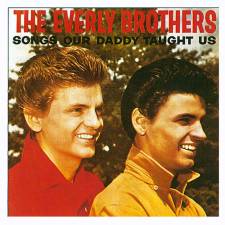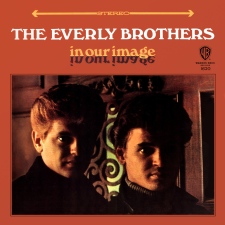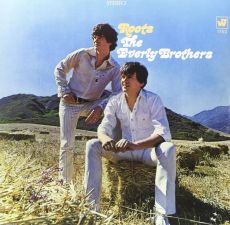The Kid Slender debut album, provisionally titled “…fulfills his manifest destiny” (Thanks Dad, great toilet euphemism), is in need of an upbeat number. So join me now as I indulge one of my teenage air guitar fantasies by mercilessly flogging my two favourite major chords, A&E, in pursuit of the Everly Brothers paean to doomed romance and self loathing “The Price Of Love”. Gin, indeed, is bitter.
Tricky chaps, Don and Phil. Their position as rock’n’roll pioneers is beyond question. Their influence over generations of artists is abundantly clear, from Brian Wilson right up to the present with the (in Sweden at least) ubiquitous First Aid Kit. Curiously though they’ve never quite achieved the iconic status of the rest of the class of ’56. Chuck Berry, Little Richard, Jerry Lee Lewis, all have graced more t-shirts than the Everlys. All have appeared in bio flicks. Hell, even Chuck’s cousin Marvin cropped up on the silver screen playing second fiddle to Michael J Fox. Yet Don and Phil seem forever to be sitting in the bleachers while the jocks get the girls. Be honest, how many of us, shown a picture of the Everly Brothers, would know which was Ron and which was Bill?
A degree of anonymity however has contributed to their longevity. Or to put it another way, the Everlys were never yoked to one image in the way that Chuck Berry will be forever duckwalking behind his Gibson 335 or Jerry Lee eternally thrashing away at the ivories, fringe flailing while his 13 year old child bride waits in the wings.
 Just check out their record sleeves for evidence. Here they are on 1958’s “Songs Our Daddy Taught Us” with a priapic leer, equally ready to tussle with Annette Funicello or Steve Reeves as the occasion demands. 1966’s “In Our Image” has the teen dream morphing into Greenwich Village existentialism courtesy of some high contrast side lighting and a turtle neck jumper
Just check out their record sleeves for evidence. Here they are on 1958’s “Songs Our Daddy Taught Us” with a priapic leer, equally ready to tussle with Annette Funicello or Steve Reeves as the occasion demands. 1966’s “In Our Image” has the teen dream morphing into Greenwich Village existentialism courtesy of some high contrast side lighting and a turtle neck jumper  and come 1968’s acclaimed “Roots” album the fellas have the Californian acid guru
and come 1968’s acclaimed “Roots” album the fellas have the Californian acid guru  look in full effect. All achieved without in any way diluting the Appalachian close harmony blueprint that birthed their first hit “Bye Bye Love”.
look in full effect. All achieved without in any way diluting the Appalachian close harmony blueprint that birthed their first hit “Bye Bye Love”.
“The Price Of Love” is the Everlys career in a nutshell. No deviation from the formula (as Mike Love was urging his Wilson cousins)…
…but what exactly was their formula? Well, clearly they copywrited (copywrote?) the early rock’n’roll demand for yearning, regret and heartfelt pleading, all wrapped up in a non threatening confection. But equally clearly they must have had something more to continue arousing this much devotion. Roy Orbison once said that he tried to recreate the sound of a fairground on a prairie in his singing. Don and Phil (can we call them “Dopherly” or something?) have something of the same distance and unattainabilty, always a little bit out of focus and out of reach. Hang on, I’m already up to 533 words and I haven’t even mentioned pencil moustaches yet…
…and only a little extra rama-lama to place it in the British invasion mid 60’s. But with an adaptability that allows you to imagine the song being played in any decade. And I do. Hank Williams, Nick Drake, The Sweet, The Raincoats, Asian Dub Foundation and Wolfmother have all cut fantasy versions of the song, available only on the Kid Slender inner iPod.
It was though, a real life flesh and blood cover that first introduced me to the song. That made me realise that teenage torment and rejection was not just going to involve staring magnificently out of rain streaked windows but would also demand ranting mysogonistically about life’s essential injustices whilst riding the crest of a self destructive shandy bass freak out. A torment which would be compensated by a lifelong love of pencil moustaches and white suits.
Bryan Ferry. I thank you.
I would love to claim that in 1976 I was down with kids, checking out NME’s young hungry gunslingers and gatecrashing the 100 club to heckle the punk rock festival. In reality I was worrying that my bike wasn’t as clean as Guy Griffiths’ and that my table tennis backhand wasn’t as unretuturnable as Lee Dixon’s. I was, mind you, beginning to cherry pick nuggets from my big brother’s record collection. One such was Bryan Ferry’s rather remarkable “Let’s Stick Together”. Remarkable not only for being glam rock’s last hurrah but for being a covers collection in which Bryan covered, mainly, himself. Leaving aside his reworking of early Roxy numbers, the album is remembered chiefly for the title track. Or to be more exact, its video.
Time tends to slow down when you watch early pop videos. We’re so used to edits at an epilepsy inducing rate that we forget the joy of watching a bunch of people staring at guitars and lip synching. Bryan and his band, the redoubtable Chris Spedding among them, attempt very little else. Most of the action appears in the form of Bryan demonstrating his unique ability to squint using only his lower eyelids. A feat which gives the impression of a man trying to squeeze out a fart silently whilst standing barefoot on lego bricks. This though, doesn’t stop him from putting in one of rock’s finest performances as he sqirms, preens and fidgets inside THAT white suit while his wonderful Ronald Coleman moustache (known in Sweden by the evocative name of “tango-rabatt”) takes on a greasy, slimy, untrustworthy life of its own. Even when Jerry Hall slinks in to deliver a middle eight of Catwoman yelping, Bryan turns to stare at her, not with the curiosity of a man checking out a saucy lady but rather to better allow her to get a load of his soup-strainer.
All this self adoration sits rather well in the context of “The Price Of Love”. Gone is the Everlys hand wringing and despair, replaced with the Ferry bravado which knows that lost love isn’t going to bother him too much. “You kiss one…. you kiss one…” he stutters, knowing full well that he’ll be kissing quite a few before Jerry decamps to Team Jagger. C’mon, he’s Bryan Ferry! He’ll be playing the tormented soul card but he’s really thinking, I’m Bryan Ferry. And you’ll never get better than that, babe.
Meanwhile, a few miles eastward along the A13, “daarn” Essex way, possibly the greatest white suit practitioner of all was plying his trade. Lee Brilleaux’s pale whistle had, like the Ferry moustache, taken on a life of its own. A life that, come 1976, appeared to involve sleeping in a ditch.
 Rock revisionism seems to have written a timeline that goes, “Louie Louie, Sgt Pepper, Stooges, Dolls, Punk”, one which thankfully, but inaccurately bypasses, “Moody Blues, Harry Nilsson, 10CC, Mike Oldfield”. In light of the latter it’s easier to understand why the appearance of Dr Feelgood in 1971 was not merely menacing but bordering on the terrifying. Lee, Wilko Johnson, John B Sparks, the Big Figure. Their names alone sound like targets for Nipper Read.
Rock revisionism seems to have written a timeline that goes, “Louie Louie, Sgt Pepper, Stooges, Dolls, Punk”, one which thankfully, but inaccurately bypasses, “Moody Blues, Harry Nilsson, 10CC, Mike Oldfield”. In light of the latter it’s easier to understand why the appearance of Dr Feelgood in 1971 was not merely menacing but bordering on the terrifying. Lee, Wilko Johnson, John B Sparks, the Big Figure. Their names alone sound like targets for Nipper Read.
The Feelgoods really shouldn’t have worked. Four unconventionally good looking lowlifes from Canvey Island with a stash of Hooker, Diddley and Burke in the boot of a borrowed MKII Cortina? By rights they should have been found out for being poseurs. The skinny kid in the playground bragging to the 5th formers about his dodgy uncle. That they weren’t and couldn’t be, depended on two things.
We can gloss over Wilko. I’ll assume I’m largely preaching to the converted and that you’re aware that he’s one of the most prodigously and unfathomably talented guitarists ever, That his songwriting aped classic blues while accommodating his own idiosyncratic style, making it impossible to do the songs justice without him. If not, I envy you the evening you have ahead of you, searching youtube.
The other ace up their well tailored sleeve is harder to pin down. For a clue we turn, oddly enough, to japanese jazz pianist and arranger Toshiko Akiyoshi. Finding herself in the fortunate position of meeting Dexter Gordon and Charles Mingus pianist Hampton Hawes, she took the opportunity to ask “How do you play the blues that way? How can I learn to play so authentically?”. “I play the blues right because I eat collard greens, black-eyed peas and corn pone and clabber” came the reply. Nobody’s fool, Akiyoshi shot back “Then where can I get such food”.
So what’s my point? Well, what Hampton was clearly saying was that authenticity isn’t something you can learn, much less buy off the peg. His style was his life. He could no more play Appalachian close harmonies with conviction than could the Everly Brothers bang out a hard bop album. Luckily for us there seems to have been a ready supply of corn pone on Canvey Island in the mid 70’s as no one could question Lee Brilleaux’s conviction. He may well appear on the same family tree as Howlin’ Wolf but he’s the bastard cousin thrice removed who doesn’t get invited round at Christmas.
Certain artists could only come from one place. Lou Reed IS New York. Depeche Mode ARE new town Essex. Motown could ONLY have existed in a mid-west industrial US city. And it’s impossible to imagine the oil refineries towering over the Thames estuary being soundtracked by anything other than Lee Brilleaux’s ursine bark.
Many singers are credited with stalking the stage. Few did it as if they were genuinely hunting something. A fellow jailbird. A wayward girlfriend. Somebody looking at him the wrong way. Somehow we were all looking at Lee Brilleaux the wrong way. All of us found wanting but all ready to be put back on the right track. If Lee was angry with us then we deserved it. Lee came along at the perfect moment of industrial decay and musical atrophy and found the perfect vehicle to document it. Or it found him. Same old blues, different fury.
Time and place. Dr Feelgood. Right time, right place. The Everly Brothers. Timeless. Any place.
Now. Does anyone fancy coming down the rub-a-dub for a pint of clabber?


And of course, the Bryan Ferry version features some particularly foxy castanet playing, which I’d like to think was added by Jerry Hall but I suspect appeared courtesy of the rather less than foxy, Morris Pert…
LikeLike
As the aforementioned owner of said album Mark, I would have expected you to point out former Family man John Wetton’s contribution on bass. Jerry’s castanet work seems to have gone uncredited but she did in fact produce the sterling mariachi trumpet intro. Fact.
LikeLike
Fab piece!
Hope all is well xx
>
LikeLike